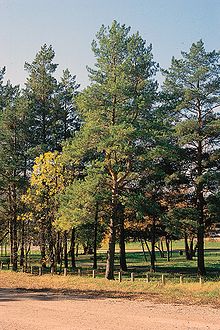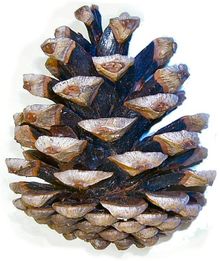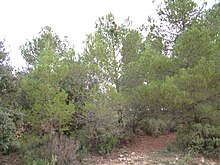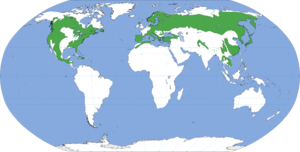Pinus halepensis Pinus pinea (Toscana ) Pinus sylvestris Tres del pins europeus junts: D'esquerra a dreta, Pi roig , pi blanc i pinassa , els pinets de sota també són pinasses, tots en estat silvestre a la Serra de Castelltallat (2012). Pinus mugo Pinus radiata Pinus canariensis Pinya de pinus nigra Pins al País Valencià Pinus gènere de conífera de la família Pinaceae pins .[ 2]
Els pins, quan creixen junts, formen boscos que s'anomenen pinedes . De diverses espècies de pins amb pinyons comestibles s'obté l'oli de pinyó amb diversos usos.[ 3]
Els pins són arbres de fulla perenne , generalment de tronc dret i elevat. La capçada pot ser piramidal o arrodonida i, en els arbres adults, ampla i deprimida. Els macroblasts presenten fulles esquamiformes sense clorofil·la . Les fulles tenen una forma acicular característica amb dos o més canals resinífers cadascuna, i s'apleguen en forma de fascicles de dues a cinc unitats en petites branquetes anomenades braquiblasts. Les espècies europees tenen totes braquiblasts amb dues fulles.
Els cons masculins es desenvolupen a la base dels brots anuals. Els estròbils presenten escates persistents, sent les tectrices rudimentàries i incluses i les seminíferes sol presentar una protuberància o melic en la seva part externa (apòfisi) maduren biennal o trienalment. Les llavors són alades amb la testa més o menys lignificada. Nombroses espècies es conreen des de molt antic pels seus pinyons o amb finalitats ornamentals o forestals, la qual cosa dificulta l'establiment de les seves àrees originals.
Els pins són plantes monoiques , amb inflorescències masculines i femenines separades en un mateix peu. Les femenines, després de pol·linitzades i madurades, es lignifiquen i es transformen en pinyes , les esquames de les quals protegeixen les llavors , anomenades pinyons . La petorrera és la pell que salta de la soca o del tronc.
Entre els antics el pi era l'arbre preferit de Demèter o Cibeles . Els coribants portaven tirs els extrems del qual eren pinyes de pi. També s'emprava la pinya en cerimònies del culte de Bacus . De vegades, es representen a Silvà amb una branca de pi a la mà dreta.
Hi ha més d'un centenar d'espècies de pins, distribuïdes per totes les latituds i altituds de l'hemisferi nord, sis de les quals es fan espontàniament als Països Catalans : el pi blanc , el pi pinyer i el pinastre , propis de la terra baixa , la pinassa o pi gargalla a la muntanya mitja , el pi roig a l'estatge montà i el pi negre a l'alta muntanya . Algunes altres (pi canari , pi insigne ) han estat introduïdes per al seu aprofitament forestal.
Existeixen al voltant de 110 espècies de pi al món. Els pins són natius de l'Hemisferi Nord , amb solament una espècie trobada al sud de l'Equador , a l'illa de Sumatra (2°S, el pi de Sumatra ). A l'Amèrica del Nord se situen des dels 66°N al Canadà (pi Jack) fins als 12°N pel sud a Nicaragua (pi del Carib). Les muntanyes subtropicals de Mèxic alberguen la major diversitat d'espècies d'aquest gènere, amb prop de 47. L'oest dels Estats Units (Califòrnia ) és el segon lloc del planeta amb més diversitat de pins. A Euràsia es troben des de les Illes Canàries i Escòcia per l'Oest fins al llunyà orient rus, i pel sud des de les Filipines fins als 70° N a Noruega i Sibèria oriental (pi roig i pi nan siberià respectivament). Set espècies són natives i originàries de la península Ibèrica i zones limítrofes i han sobreviscut i desenvolupat des de temps remots. En el nord d'Àfrica existeixen pins a les zones muntanyenques, així com en els Himalaies i en el sud-est asiàtic. S'han introduït pins en àrees temperades i subtropicals de l'Hemisferi Sud, incloent l'Argentina , el Brasil , Xile , l'Equador , Uruguai , el Paraguai , Nova Zelanda i Austràlia , on creixen extensament com a recurs de la fusta , i inclusivament algunes espècies s'han convertit en invasores.
Llista de pins per regions
Regió europea i mediterrània (alguna espècie estesa fins a Àsia)
Àsia
Canadà i EUA, excepte àrees properes a la frontera mexicana
Sud d'Arizona i Nou Mèxic, Mèxic, Amèrica central i Carib
↑ Entrada «Pinus » de la Paleobiology Database (en anglès). [Consulta: 20 desembre 2022].
↑ «Noms de plantes. Corpus de fitonímia catalana | TERMCAT ». [Consulta: 12 març 2023]. ↑ August Holmes. Some of the Physical Constants of Pine Nut Oil ↑ Pines of Silvicultural Importance ISBN 978-0-85199-539-7 ↑ Aylmer Bourke Lambert. A Description of the Genus Pinus: With Directions Relative to the Cultivation, and Remarks on the Uses of the Several Species: Also Descriptions of Many Other New Species of the Family of Coniferae : Illustrated with Figures ↑ Marcus Ulber; Felix Gugerli; Gregor Božič Pinus cembra ISBN 978-92-9043-619-5 ↑ Diccionario de Agricultura práctica y Economía Rural ↑ LOPEZ GONZALEZ, GINES. GUÍA DE LOS ÁRBOLES Y ARBUSTOS DE LA PENÍNSULA IBÉ: (especies silvestres y las cultivadas más comunes) ISBN 978-84-8476-210-2 ↑ Station Paper ↑ General Technical Report INT. ↑ J. A. Gómez Loranca. Pinus nigra Arn. en el sistema ibérico: tablas de crecimiento y producción ISBN 978-84-7498-449-1 ↑ Breeding and Genetic Resources of Five-needle Pines: Growth, Adaptability, and Pest Resistance : Proceedings of the IUFRO Five-Needle Pine Working Party Conference, July 23-27, 2001, Medford, Oregon, USA ↑ Selvicultura del pino pinaster (pinus pinaster): manual básico : cuidados culturales del pino pinaster en Asturias para producir madera de calidad ↑ Marta San José Valdezate. Evaluación de las masas de pino piñonero (Pinus pinea L.) en la Reserva Biológica de Doñana, Parque Nacional de Doñana: proyecto fin de carrera ↑ United States Congressional Serial Set ↑ Aljos Farjon. Pines, 2nd revised edition: Drawings and Descriptions of the Genus Pinus ISBN 978-90-474-1516-9 ↑ Aljos Farjon. A Handbook of the World's Conifers (2 vols.): Revised and Updated Edition ISBN 978-90-04-32451-0 ↑ Rajeev K. Srivastava; Nawa Bahar Pines of South-East Asia ISBN 978-81-7089-343-1 ↑ Pacific Forestry Centre; International Union of Forestry Research Organizations. Project Group P2.04-00 (Seed Problems) Dormancy and Barriers to Germination: Proceedings of an International Symposium of IUFRO Project Group P2.04-00 (Seed Problems) ISBN 978-0-662-20777-1 ↑ William Burke Critchfield; Elbert Luther Little Geographic Distribution of the Pines of the World ↑ Aljos Farjon; Denis Filer An Atlas of the World's Conifers: An Analysis of their Distribution, Biogeography, Diversity and Conservation Status ISBN 978-90-04-21181-0 ↑ Kyōto Daigaku. Nōgakubu. Memoirs of the College of Agriculture, Kyoto University ↑ 23,0 23,1 Willdenowia ↑ Elbert Luther Little; William Burke Critchfield Subdivisions of the Genus Pinus (pines) ↑ 台灣林業科學 ↑ Diversity and Systematics of Seed Plants ISBN 978-81-7133-792-7 ↑ Issues in Ecological Research and Application: 2013 Edition ISBN 978-1-4901-0658-8 ↑ Shun-chʻing Li. Forest Botany of China, Supplement ↑ K. J. Crockford. Spacing Trials of Pinus Kesiya: Results and Recommendations ↑ David M. Richardson. Ecology and Biogeography of Pinus ISBN 978-0-521-78910-3 ↑ Pinus krempfii. Lecomte 1921. ↑ Pinus latteri. Mason. 1849. ↑ Pinus luchuensis. Mayr 1894. ↑ Pinus massoniana ↑ William Burke Critchfield; Elbert Luther Little Geographic Distribution of the Pines of the World ↑ 36,0 36,1 Silvicultura de bosques tropicales: bibliografía ↑ F.A. Andersson. Coniferous Forests ISBN 978-0-444-81627-6 ↑ P A Khomentovsky. Ecology of Siberian Dwarf Pine Pinus Pumila (Pallas) Regel in Kamchatka ISBN 978-1-4822-7992-4 ↑ Raja Walayat Hussain; E. B. Glennie; M. Afzal Cheema Interim Yield Tables for Chir Pine (Pinus Roxburghii, Roxb) of Reserved Forests in the Punjab ↑ Elena I. Troeva; A. P. Isaev; M.M. Cherosov The Far North:: Plant Biodiversity and Ecology of Yakutia ISBN 978-90-481-3971-2 ↑ 41,0 41,1 Mark Cochrane. Tropical Fire Ecology: Climate Change, Land Use and Ecosystem Dynamics ISBN 978-3-540-77381-8 ↑ Ram Swaroop Meena; Rahul Datta Soil Moisture Importance ISBN 978-1-83968-095-3 ↑ Elbert Luther Little; William Burke Critchfield Subdivisions of the Genus Pinus (pines) ↑ Max Lehey. Black Pine (pinus Thunbergii) "King of Bonsai" ↑ Bhupendra Koul. Herbs for Cancer Treatment ISBN 978-981-329-147-8 ↑ Sharad Singh Negi. Himalayan Wildlife, Habitat and Conservation ISBN 978-81-85182-68-1 ↑ De-Yuan Hong; Stephen Blackmore The Plants of China ISBN 978-1-107-07017-2 ↑ Tadej Slabe. South China Karst II ISBN 978-961-254-241-2 ↑ Stephen F. Arno. Silvics of Whitebark Pine (Pinus Albicaulis) ↑ Karl Hess. Forest Vegetation of the Arapaho and Roosevelt National Forests in Central Colorado: A Habitat Type Classification ↑ Charles R. Hatch; Phyllis M. Faber Trees of the California Landscape: A Photographic Manual of Native and Ornamental Trees ISBN 978-0-520-25124-3 ↑ M.M. Grandtner. Elsevier's Dictionary of Trees: Volume 1: North America ISBN 978-0-08-046018-5 ↑ William Graham Cole. Growth Response and Water Use Efficiency of Pinus Banksiana and Pinus Resinosa Seedlings Under Controlled Moisture Regimes ↑ Cuauhtémoc Sáenz Romero. Landscape Genetics of Pinus Banksiana Lamb. in Wisconsin: Spatial Variation of Quantitative Traits and Isoenzymes ↑ Elwood LaVern Miller. Studies of Environmental Factors Affecting Jack Pine (Pinus Banksiana Lamb.) Regeneration ↑ David Stephen Canavera. Geographic and Stand Variation in Jack Pine (Pinus Banksiana Lamb) ↑ Kenneth W. Outcalt. An Old-growth Definition for Sand Pine Forests ↑ G. E. Rehfeldt. Ecological Genetics of Pinus Contorta in the Lower Snake River Basin of Central Idaho ↑ Donald L. Copes. Graft Incompatibility in Pinus Contorta ↑ Ze'ev Vered. Auxin in Long Shoots of Coulter Pine (Pinus Coulteri) ↑ Charles Theodore Mohr. The Timber Pines of the Southern United States ↑ William A. Dick-Peddie. New Mexico Vegetation: Past, Present, and Future ISBN 978-0-8263-2164-0 ↑ K. J. Crockford. Yield Models and Tables for Pinus Patula, Pinus Elliottii and Pinus Taeda in Zimbabwe ↑ Food and Agriculture Organization of the United Nations. An Annotated Bibliography of Pinus Elliottii ↑ John F. Kraus. Heritability of Some Seed Characteristics in Slash Pine (Pinus Elliottii Engelm.) ↑ David William Langor. Status of the Limber Pine (Pinus Flexilis) in Alberta ISBN 978-0-7785-7068-4 ↑ United States. Forest Service. Report of the Chief - Forest Service ↑ José Elorrieta y Artaza. Ensayo de los pinos ponderosa y jeffreyi en la vertiente sur de Sierra Nevada (Granada) años 1922 a 1962 ↑ Harold Scofield Betts. Sugar Pine (Pinus Lambertiana) ↑ Stanley Liebert Krugman. The Anthocyanin Leuco-anthocyanins of Sugar Pine (Pinus Lambertiana Dougl.) Seedlings ↑ Joseph Albert Sacher. Structure and Histogenesis of the Buds of Pinus Lambertiana ↑ Peter H. Raven; Ray Franklin Evert; Susan E. Eichhorn Biología de las plantas ISBN 978-84-291-1842-1 ↑ Trevor A. Burwell. Environmental History of the Lower Montane Pinyon (Pinus Monophylla) Treeline, Eastern California ↑ Raymond J. Hoff; Geral I. McDonald; R. T. Bingham Resistance to Cronartium ribicola in Pinus monticola: structure and gain of resistance in the second generation ↑ K. Van Cleve. A Study of the Nitrogen Economy of Bishop Pine (Pinus Muricata) Stands of Various Ages ↑ Thomas C. Croker. Longleaf Pine: an Annotated Bibliography, 1946 Through 1967 ↑ G. E. Rehfeldt. Adaptive Variation in Pinus Ponderosa from Intermountain Regions: Middle Columbia River system. II. ↑ Raymond C. Shearer. Performance of 14-year-old Pinus Ponderosa Hybrids in Western Montana ↑ Bruce Allen Follansbee. In Vitro Culture Studies of Pinus Ponderosa Laws ↑ Thomas Meehan. Pinus Pungens: The Table Mountain Pine ↑ Alfonso Fernández Manso; Alfonso Sarmiento Maíllo El pino radiata (Pinus radiata): manual de gestión forestal sostenible ↑ Felipe Crecente-Campo. Modelo de crecimiento de árbol individual para Pinus radiata D. Don en Galicia. ↑ Esther Fernández Núñez. Sistemas silvopastorales establecidos con Pinus radiata D. Don y Betula alba L. en Galicia. ↑ Nicolás Marcelo Gálvez Arévalo. Determinación de la composición química de madera de pino insigne (pinus radiata D. Don) sometida a la acción de dos hongos de pudrición blanca ↑ Nicholas Tiho Mirov. Composition of Gum Turpentines of Pines ↑ David M. Richardson. Ecology and Biogeography of Pinus ISBN 978-0-521-78910-3 ↑ Harold Scofield Betts. Red Pine (Pinus Resinosa) ↑ Douglas E. Gritzinger. Short Term Dynamics of Potassium Cycling in Pinus Resinosa ↑ James Edward Stone. Water Conduction in Roots and Root Grafts of Pinus Resinosa ↑ Orville W. Moore. Red Pine (Pinus Resinosa) Seedlings as Affected by Various Soil Treatments ↑ Silas Little; Jack McCormick; John W. Andresen A Selected and Annotated Bibliography of Pitch Pine (Pinus Rigida Mill.) ↑ Boy Scouts of America. Handbooks for Boys ↑ Michael A. Taras; J. R. Saucier Wood Density Surveys of the Minor Species of Yellow Pine in the Eastern United States: Pond pine (Pi̲ṉu̲s̲ ̲se̲ṟo̲ṯi̲ṉa̲ ̲Michx.) ↑ Eugenio Plá y Ravé. Tratado de maderas de construccion civil y naval ↑ Growth and Yield Model for Pinus Taeda and Pinus Elliottil in Brizil ↑ United States. Forest Service. Torrey Pine: Pinus Torreyana Parry ↑ Patterns of Reproduction in Torrey Pine (Pinus Torreyana) ↑ A. D. Lindsay. Torrey Pine (Pinus Torreyana Parry) ↑ Population Trends and Recruitment Patterns of Pinus Torreyana at the Torrey Pine State Reserve ↑ Arthur Pierson Kelley. The Variations in Form of Mycorrhizal Short-roots of Pinus Virginiana Mill. Associated with Certain Soil Series ↑ Boletin tecnico ↑ Víctor M. Cano Gutiérrez. Tabla de densidad para pinus arizonica ↑ Miguel Angel Musálem; Alvaro Ramírez Luis Monografía de Pinus ayacahuite var. veitchii Shaw ISBN 978-968-5580-06-9 ↑ TRES INTENSIDADES DE RALEO EN PINUS CARIBAEA var HONDURENSIS; ANALISIS DE 10 ANOS DE CRECIMIENTO EN UN DISENO CUADRADO LATINO ↑ Pastoreo Bajo Plantaciones de Pinus Caribaea Informe de Investigacion 1984-1985 Proyecto Agroforestal Unu/catie ↑ Datos De Crecimiento De Pinus Caribaea Var. Hondurensis En La Reserva Forestal La Yeguada, Panama ↑ Growth and Site Relationships of Pinus Caribaea Across the Caribbean Basin ↑ Jacob L. Whitmore. Spacing Trial of Pinus Caribaea Var. Hondurensis ↑ Phytologia ↑ Jeffery A. Wright. Conservación y uso del recurso genético de Pinus chiapensis en Colombia ↑ Estimación de biomasa y contenido de carbono de Pinus cooperi Blanco, en Pueblo Nuevo, Durango ↑ David M. Richardson. Ecology and Biogeography of Pinus ISBN 978-0-521-78910-3 ↑ Francisco Adolfo Sauvalle. Flora cubana ↑ Guias botánicas de excursiones en México: Sureste, Noroeste y Noreste, Cañon de Lobos, Los Volcanes, Meztitlan, El Mezquital ↑ INEGI. Anuario estadístico y geográfico de Michoacán de Ocampo 2014 ↑ INEGI. Explotación de pino en el estado de Durango ↑ Basilio Bermejo-Velazquez. Genetic Diversity and the Mating System in Pinus Engelmannii Carr ↑ J. P. Perry (Jr.). The Taxonomy and Chemistry of Pinus Estevezii ↑ Paul Carpenter Standley. Trees and Shrubs of Mexico ISBN 978-0-598-40856-3 ↑ Miguel Angel Musálem; Gabriel Martínez Cantera Monografía de Pinus Greggii Engelm ISBN 978-968-5580-03-8 ↑ Olman Murillo. Natural Variation in Wood Specific Gravity of Pinus Greggii, P. Leiophylla and P. Pringlei ↑ Villers Ruiz, Lourdes; Fabiola Rojas García; Pedro Tenorio Lezama Guia Botanica Del Parque Nacional Malinche. Tlaxcala-puebla ISBN 978-970-32-1844-8 ↑ Abisaí J. García-Mendoza; María de Jésus Ordóñez Díaz; Miguel Briones-Salas Biodiversidad de Oaxaca ISBN 978-970-32-2045-8 ↑ Freddy Eduardo Rojas-Rodríguez; Edgar Ortiz Pino Caribe: Pinus caribaea Morelet var. hondurensis (Barret y Golfari) : especie de árbol de uso múltiple en América Central ISBN 978-9977-57-104-1 ↑ Antología botánica del estado de Jalisco, México ↑ Ronald M. Lanner. The Pinon Pine: A Natural And Cultural History ISBN 978-0-87417-412-0 ↑ Alcántara, Manuel; García Montero, Mercedes; Sánchez López, Francisco Historia y Patrimonio Cultural: Memoria del 56.º Congreso Internacional de Americanistas ISBN 978-84-9012-927-2 ↑ Maximino Martínez. Plantas utiles de la flora Mexicana ↑ Baldemar Arteaga Martínez; Horacio García Rodríguez; Juan Gabriel Rivera Medrano Piñón grande: pinus maximartinezii rzedowski ISBN 978-968-884-322-2 ↑ W. S. Dvorak; J. K. Donahue Pinus Maximinoi Seed Collections in Mexico and Central America ↑ Fernando Carrillo Anzures. Natural Regeneration in Pinus Montezumae Forests of Central Mexico ↑ INEGI. Anuario estadístico del estado de Nuevo León 2008. Tomo I ↑ Santiago Wigberto Bueno Lopez; Eddie Bevilacqua Predicción de Distribuciones Diamétricas Para Pinus Occidentalis ISBN 978-3-8484-7507-0 ↑ Bibliografía sobre Pinus occidentalis ↑ Estudio de la Masa Forestal del Bosque de Pinus Oocarpa de yucul (Nicaragua) Atacado pr Dendroctuonus Frontalis ↑ Leonidas Vega Condori. Observaciones silviculturales de pinus patula Schel & Chan: en Cundinamarca, Colombia ↑ A. E. Squillace. Classification of Pinus Patula, P. Tecunumanii, P. Oocarpa, P. Caribaea Var. Hondurensis, and Related Taxonomic Entities ↑ Jessica Dawn Palmer. The Apache Peoples: A History of All Bands and Tribes Through the 1880s ISBN 978-1-4766-0195-3 ↑ C.L. Diaz Luna. Estudio cromosomico de Pinus pinceana Gordon ↑ Potencial dendroclimático de Pinus pinceana Gordon en la sierra madre oriental ↑ Posibilidades de Introducir Algunas Coniferas de Mexico Y America Central en Colombia ↑ Carlos Reiche C.. Costos del cultivo de árboles de uso múltiple en América Central ISBN 978-9977-57-110-2 ↑ José Delgadillo; José Delgadillo Rodríguez El bosque de coníferas de la Sierra de San Pedro Mártir, Baja California ISBN 978-968-817-702-0 ↑ United States. Forest Service. Four-leaf Piñon: Pinus Quadrifolia Parl ↑ Aljos Farjon. A Handbook of the World's Conifers: Revised and Updated Edition ISBN 978-90-474-3062-9 ↑ Hugh H. Genoways; Robert J. Baker Biological Investigations in the Guadalupe Mountains National Park, Texas: Proceedings of a Symposium Held at Texas Tech University, Lubbock, Texas, April 4-5, 1975 ↑ W. S. Dvorak; E. A. Shaw Five Year Results for Growth and Stem Form of Pinus Tecunumanii in Brazil, Colombia and South Africa ↑ José Alcina Franch; Miguel León Portilla; Eduardo Matos Moctezuma Azteca Mexica ISBN 978-84-7782-203-5 ↑ George Russell Shaw. The Pines of Cuba: Pinus Tropicalis (Morelet), Pinus Caribaea (Morelet), Pinus Cubensis (Grisebach).
Bases de dades taxonòmiques
Viccionari













